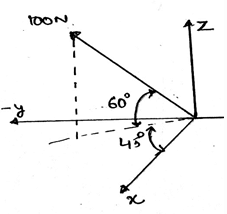Test: Different Free Body Diagrams - Mechanical Engineering MCQ
15 Questions MCQ Test - Test: Different Free Body Diagrams
Just like the collinear forces for free body diagrams there are collinear couple and the net moment is taken out from it.
The simplification of the forces on the free body diagrams is done as __________
| 1 Crore+ students have signed up on EduRev. Have you? Download the App |
In the figure given below, calculate the value of cosγ. (γ is the angle made by the resultant vector and the z-axis)

The system of the collinear and the parallel force in free body diagrams are simplified as _________
The couple is a scalar quantity and the force is vector quantity and hence only force can be simplified in free body diagrams.
The couple is simplified easily by the help of right hand rule in free body diagrams. But the forces simplification is not possible as there is no such system of rules so that the forces can be simplified.
The couple and the other two force systems in free body diagrams can be easily simplified.
Determine the vertical components of the reaction on the beam at pin Q.
The force and the couple can’t be simplified together as one is the cause and the other is the effect in free body diagrams.
What is a collinear system of forces for free body diagrams?
The main moto of the free body diagrams is to:
The couple moment and the force is divided to get the distance of the axis from the point of action of the force in free body diagrams.
The simplification of the couple is done for free body diagrams on the basis of the:
Principle of transmissibility for free body diagrams is:
Just like the collinear force system for free body diagrams there is a system of the parallel forces.

















